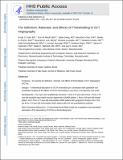| dc.contributor.author | Cole, Emily D. | |
| dc.contributor.author | Moult, Eric Michael | |
| dc.contributor.author | Dang, Sabin | |
| dc.contributor.author | Choi, Woo Jhon | |
| dc.contributor.author | Ploner, Stefan B | |
| dc.contributor.author | Lee, ByungKun | |
| dc.contributor.author | Louzada, Ricardo | |
| dc.contributor.author | Novais, Eduardo | |
| dc.contributor.author | Schottenhamml, Julia Jennifer | |
| dc.contributor.author | Maier, Andreas | |
| dc.contributor.author | Fujimoto, James G | |
| dc.contributor.author | Waheed, Nadia K. | |
| dc.contributor.author | Duker, Jay S. | |
| dc.contributor.author | Husvogt, Lennart | |
| dc.date.accessioned | 2019-07-10T17:21:10Z | |
| dc.date.available | 2019-07-10T17:21:10Z | |
| dc.date.issued | 2017-09 | |
| dc.identifier.issn | 2468-7219 | |
| dc.identifier.issn | 2468-6530 | |
| dc.identifier.uri | https://hdl.handle.net/1721.1/121566 | |
| dc.description.abstract | PURPOSE: To examine the definition, rationale, and effects of thresholding in OCT angiography (OCTA). DESIGN: A theoretical description of OCTA thresholding in combination with qualitative and quantitative analysis of the effects of OCTA thresholding in eyes from a retrospective case series. PARTICIPANTS: Four eyes were qualitatively examined: 1 from a 27-year-old control, 1 from a 78-year-old exudative age-related macular degeneration (AMD) patient, 1 from a 58-year-old myopic patient, and 1 from a 77-year-old nonexudative AMD patient with geographic atrophy (GA). One eye from a 75-year-old nonexudative AMD patient with GA was quantitatively analyzed. MAIN OUTCOME MEASURES: A theoretical thresholding model and a qualitative and quantitative description of the dependency of OCTA on thresholding level. RESULTS: Due to the presence of system noise, OCTA thresholding is a necessary step in forming OCTA images; however, thresholding can complicate the relationship between blood flow and OCTA signal. CONCLUSIONS: Thresholding in OCTA can cause significant artifacts, which should be considered when interpreting and quantifying OCTA images. | en_US |
| dc.description.sponsorship | Macula Vision Research Foundation | en_US |
| dc.description.sponsorship | National Institutes of Health (U.S.) (NIH R01-EY011289-29A) | en_US |
| dc.description.sponsorship | National Institutes of Health (U.S.) (R44-EY022864) | en_US |
| dc.description.sponsorship | National Institutes of Health (U.S.) (R01-CA075289-16) | en_US |
| dc.description.sponsorship | United States. Air Force. Office of Scientific Research (AFOSR FA9550-15-1-0473) | en_US |
| dc.description.sponsorship | United States. Air Force. Office of Scientific Research (FA9550-12-1-0499) | en_US |
| dc.description.sponsorship | Praevium Research Inc. | en_US |
| dc.description.sponsorship | Massachusetts Lions Clubs | en_US |
| dc.description.sponsorship | Samsung (Firm) (Scholarship) | en_US |
| dc.language.iso | en | |
| dc.publisher | Elsevier BV | en_US |
| dc.relation.isversionof | 10.1016/J.ORET.2017.01.019 | en_US |
| dc.rights | Creative Commons Attribution-NonCommercial-NoDerivs License | en_US |
| dc.rights.uri | http://creativecommons.org/licenses/by-nc-nd/4.0/ | en_US |
| dc.source | PMC | en_US |
| dc.title | The Definition, Rationale, and Effects of Thresholding in OCT Angiography | en_US |
| dc.type | Article | en_US |
| dc.identifier.citation | Cole, Emily D., et al. “The Definition, Rationale, and Effects of Thresholding in OCT Angiography.” Ophthalmology Retina 1, no. 5 (September 2017): 435–47. | en_US |
| dc.contributor.department | Harvard University--MIT Division of Health Sciences and Technology | en_US |
| dc.contributor.department | Massachusetts Institute of Technology. Institute for Medical Engineering & Science | en_US |
| dc.contributor.department | Massachusetts Institute of Technology. Department of Electrical Engineering and Computer Science | en_US |
| dc.relation.journal | Ophthalmology Retina | en_US |
| dc.eprint.version | Author's final manuscript | en_US |
| dc.type.uri | http://purl.org/eprint/type/JournalArticle | en_US |
| eprint.status | http://purl.org/eprint/status/PeerReviewed | en_US |
| dc.date.updated | 2019-06-26T15:56:23Z | |
| dspace.date.submission | 2019-06-26T15:56:24Z | |
